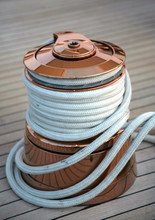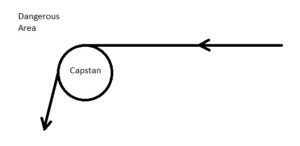Capstans

Notes:
- A capstan is a round, cylindrical post that is typically hydraulically powered with the capacity to turn in order to haul on line.
- Once a line is wrapped around a capstan several times, the friction of the line around the capstan is often enough for the capstan to apply it’s pulling power to the line without slipping
- Using a capstan requires a person to:
- tend the line coming off of the capstan in order to maintain tension
- make sure the incoming line doesn’t cross over existing wraps on the capstan
- handle capstan controls
- They are especially useful when mooring large ships as they can apply powerful forces to mooring lines in order to tightly secure the vessel
- Best practices and cautions:
- When mooring large vessels, the use of fairleads or hawseholes is important so the mooring line doesn’t chafe badly and has a controlled location from which to apply its tension
- When mooring, the tension and location of mooring lines is typically managed in coordination with bridge officers so as to position the vessel appropriately and to apply an even and appropriate amounts of tension in forward and aft locations. Radios are commonly used to help individuals better coordinate these mooring activities.
- When first applying wraps of a line around a capstan that is secured to a fixed point that could come tight, good habit is to always push the line around the top of the capstan using only the palm of your hand so that if it ever drew back tightly, none of the hand’s digits and especially thumb could become pinched
- When using twisted strand rope (especially with natural fiber rope) it is good practice to wind the rope around the capstan in the same direction as the lay of the rope (a right hand lay rope should be wound around the capstan and hauled on in a clockwise direction). This helps to prevent kinking and twisting of the rope.
- Be wary of the outside arc when hauling in line because in the event the line parts, it will typically snap back towards the outer area shown below

